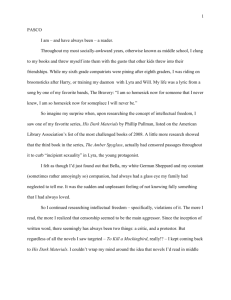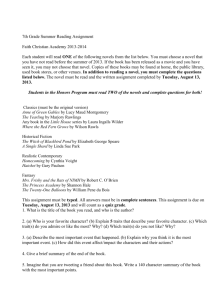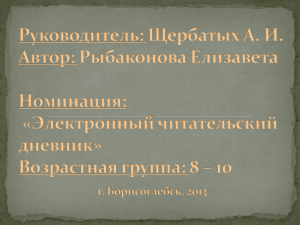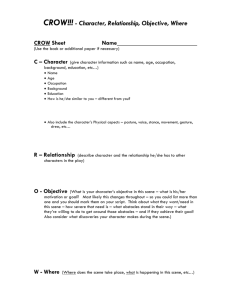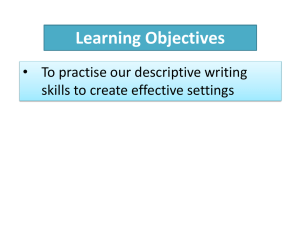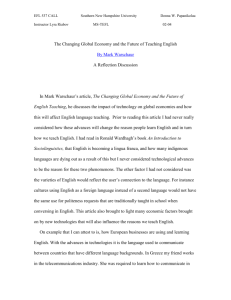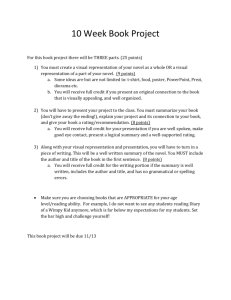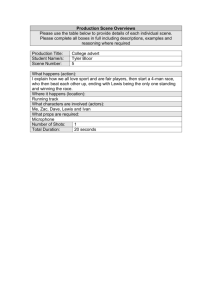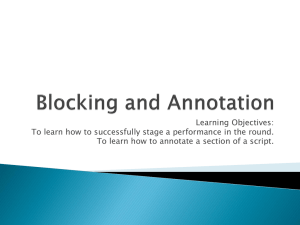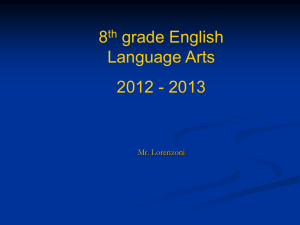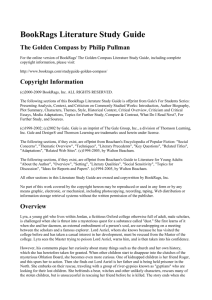From Novel to Performance
advertisement
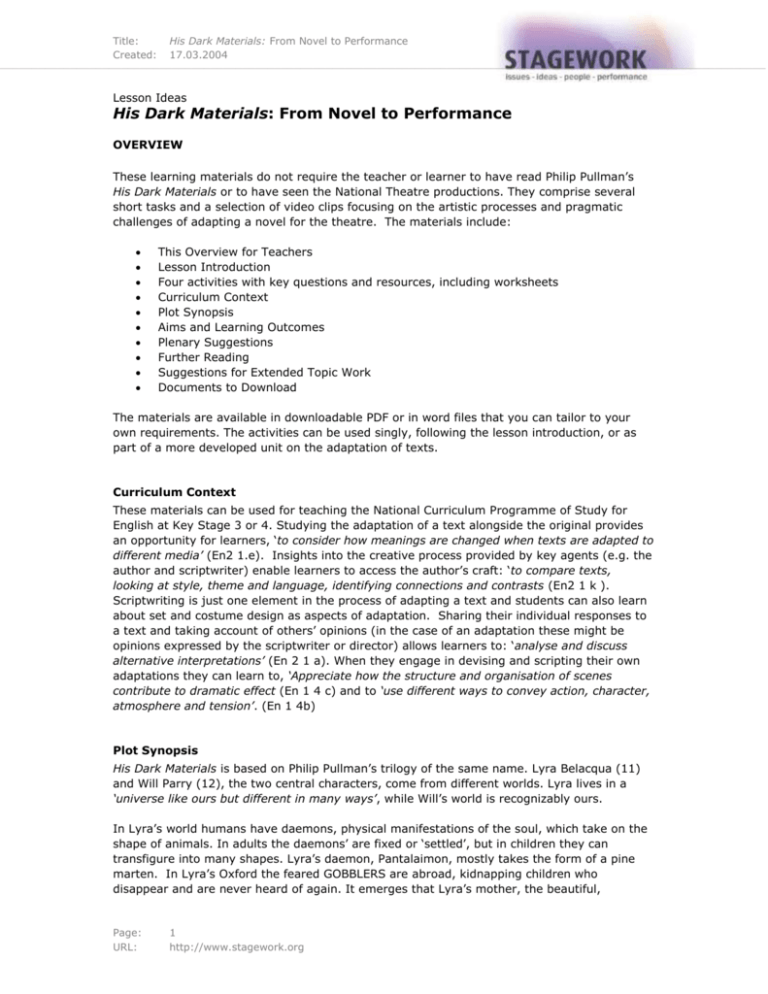
Title: His Dark Materials: From Novel to Performance Created: 17.03.2004 ________________________________________________________________________________________________________________________ Lesson Ideas His Dark Materials: From Novel to Performance OVERVIEW These learning materials do not require the teacher or learner to have read Philip Pullman’s His Dark Materials or to have seen the National Theatre productions. They comprise several short tasks and a selection of video clips focusing on the artistic processes and pragmatic challenges of adapting a novel for the theatre. The materials include: This Overview for Teachers Lesson Introduction Four activities with key questions and resources, including worksheets Curriculum Context Plot Synopsis Aims and Learning Outcomes Plenary Suggestions Further Reading Suggestions for Extended Topic Work Documents to Download The materials are available in downloadable PDF or in word files that you can tailor to your own requirements. The activities can be used singly, following the lesson introduction, or as part of a more developed unit on the adaptation of texts. Curriculum Context These materials can be used for teaching the National Curriculum Programme of Study for English at Key Stage 3 or 4. Studying the adaptation of a text alongside the original provides an opportunity for learners, ‘to consider how meanings are changed when texts are adapted to different media’ (En2 1.e). Insights into the creative process provided by key agents (e.g. the author and scriptwriter) enable learners to access the author’s craft: ‘to compare texts, looking at style, theme and language, identifying connections and contrasts (En2 1 k ). Scriptwriting is just one element in the process of adapting a text and students can also learn about set and costume design as aspects of adaptation. Sharing their individual responses to a text and taking account of others’ opinions (in the case of an adaptation these might be opinions expressed by the scriptwriter or director) allows learners to: ‘analyse and discuss alternative interpretations’ (En 2 1 a). When they engage in devising and scripting their own adaptations they can learn to, ‘Appreciate how the structure and organisation of scenes contribute to dramatic effect (En 1 4 c) and to ‘use different ways to convey action, character, atmosphere and tension’. (En 1 4b) Plot Synopsis His Dark Materials is based on Philip Pullman’s trilogy of the same name. Lyra Belacqua (11) and Will Parry (12), the two central characters, come from different worlds. Lyra lives in a ‘universe like ours but different in many ways’, while Will’s world is recognizably ours. In Lyra’s world humans have daemons, physical manifestations of the soul, which take on the shape of animals. In adults the daemons’ are fixed or ‘settled’, but in children they can transfigure into many shapes. Lyra’s daemon, Pantalaimon, mostly takes the form of a pine marten. In Lyra’s Oxford the feared GOBBLERS are abroad, kidnapping children who disappear and are never heard of again. It emerges that Lyra’s mother, the beautiful, Page: URL: 1 http://www.stagework.org Title: His Dark Materials: From Novel to Performance Created: 17.03.2004 ________________________________________________________________________________________________________________________ ambitious Mrs. Coulter and her cruel Golden Monkey daemon are involved with the GOBBLERS. When Lyra’s friend Roger disappears, she is determined to find him and bring him home. Her quest takes her from Jordan College in Oxford to the far North where she is befriended by armoured bears, witches, and Lee Scoresby a Texan aeronaut. Lyra carries with her an Alethiometer, a truth-telling compass which she intuitively learns to read, although it takes scholars many years to acquire the skill. Meanwhile, Lyra’s uncle, Lord Asriel (whom she later learns is her father) is preparing an expedition to the Arctic to investigate the mysterious phenomenon, Dust. He has secured funding for his trip by demonstrating to the Oxford scholars the existence of an alternative world visible through the Dust. Will Parry is an ordinary boy from our world, though he has committed an extraordinary act – murder. On the run after his terrible crime, he stumbles through a window into another world, Cittàgazze, where children seem to rule and dreaded Spectres prey on the souls of adults. In this world Will meets and befriends Lyra. The two soon find themselves in search of a small but extremely powerful weapon – the Subtle Knife – capable of cutting a window between the worlds. Will’s search for his lost father, and Lyra’s for Roger and the truth about Dust, drive the story forward. As their quest advances, there are rumours of an impending war between the Kingdom of Heaven, ruled by the Authority, and the newly formed Republic of Heaven, under the command of Lord Asriel. Lyra and Will, armed with the Alethiometer and the Subtle Knife, embark on a quest that will change the course of history. They travel to the Land of the Dead and encounter the ancient and dying Authority. As Will and Lyra move into young adulthood, innocence turns to experience. They develop a new awareness of each other and are forced to make a painful sacrifice, putting the collective good before individual need. Aims At the end of this unit students will: understand that the process of adaptation is an act of interpretation; appreciate that an adaptation is an art form in its own right and should be judged on its own merits; be able to identify some of the artistic and technical challenges presented when adapting a novel for the theatre; apply their newly acquired knowledge and understanding in developing their own ideas for adapting a scene, or realising character or setting. Learning Outcomes Analysis of character and development of a concept/costume Group presentation of a concept design for a scene including justification of ideas with reference to the texts Script for a short scene adapted from an episode in Northern Lights LESSON INTRODUCTION This lesson is designed to: Help learners build on their experiences of adaptations, moving from the sharing of implicit knowledge to explicit critical reflection. Raise students’ awareness of adaptations by talking about screen, television and stage adaptations they are familiar with (e.g. Lord of the Rings). Start by asking students to describe a favourite adaptation and explain why they enjoyed it. Page: URL: 2 http://www.stagework.org Title: His Dark Materials: From Novel to Performance Created: 17.03.2004 ________________________________________________________________________________________________________________________ Discuss the delights and disappointments of watching an adaptation after reading a book. Note that adapting a book for stage or screen is a CREATIVE process which involves interpreting the original text. No two people respond to a book in exactly the same way. Read text: Adaptation View video extract: Nicholas Wright interview: Adapting The Novels. Then consider reasons that changes might be made when adapting a novel for a stage play (e.g. compression, narrative order may need to be changed, rationalisation of characters). ACTIVITY 1 ADAPTATION: BOOK TO SCRIPT Following the opening discussion ask the students to identify some characteristic features of novels and plays. In pairs, ask them to produce a ‘thought shower’ using a blank grid to aid note making. (see Worksheet 1). EXAMPLE These points are illustrative and are not intended to be exhaustive. Novels Plays Writing a novel is usually a SOLITARY activity Can include NARRATIVE (story-telling), DESCRIPTION (word-painting) and Dialogue (direct and indirect speech and thought) Reading TIME may extend over a period of days, weeks or even months. Novels generally have far more words than plays. CHARACTER introduced in different ways, description, dialogue, authorial comment etc SETTING described VIEWPOINT in a novel may be from a first or third person (rarely second) perspective. Most frequently a novel is focused through the eyes of one or two major characters. Novel may use symbol, imagery or other figurative language THOUGHT can be reported and commented on, May use symbol, imagery and other figurative language Needs ACTION which is performed by ACTORS Performed to an AUDIENCE Needs a performance SPACE ACTION is accompanied by DIALOGUE Visual aspects of CHARACTER and SET have to be physically realised PERFORMANCE may be accompanied by music and sound, though not essential Adapting a novel from page to stage is a COLLABORATIVE process involving writer, director, set and costume designers, actors etc. DRAMATIC TENSION Running TIME usually 2 – 3 hours Objective VIEWPOINT. Action shows events rather than tells about them. THOUGHT is revealed in action. Occasionally a character might voice their thoughts in a DIRECT ADDRESS to the audience or by speaking to themselves May use POETIC devices such as symbolic artefacts Whole class or small group: Ask the students to make notes on the points made about the differences between novel and script in the following video extracts (notes can be jotted on Page: URL: 3 http://www.stagework.org Title: His Dark Materials: From Novel to Performance Created: 17.03.2004 ________________________________________________________________________________________________________________________ Worksheet 1: Philip Pullman on script (e.g. condensing 35 hours of read-aloud time into 6 hours of performance; 5 minutes of narrative description can be revealed in a moment on stage; less time does not mean less story) Nicholas Wright on adapting the novels (e.g. changes may be made to move the story forward more quickly; audiences prefer to follow the development of one character so there may be some rationalisation of characters) Working in pairs, ask students to extend the list of differences by reviewing and extracting information from their notes on the characteristics of novels and plays. They can do the same thing for similarities. EXAMPLE These points are illustrative and are not intended to be exhaustive. Similarities Differences Tell stories Include characters Use dialogue Have a problem, conflict or source of tension TIME. A novel may take 12 hours to read but a play is enacted over a shorter period Reading is largely a solitary experience, watching a play is a collective experience Settings and characters are physically realised in plays but have to be described, realised through dialogue or action in novels Watching a performance is a multi-sensory experience. a play may be accompanied by sound and music. Review the list of similarities and differences and consider the implications for adaptation. (e.g. character and setting have to be physically realised; it is likely that a novel will have to be condensed; narrative order may need to be changed to make the story work in performance). ACTIVITY 2 REALISING CHARACTER Students will need access to a copy of the text Lyra meets Iorek Byrnison either on screen or a paper copy. Read the passage aloud. Ask the students what they found interesting or surprising in this scene. What questions does the passage raise for them? In pairs ask students to annotate the text, highlighting the words and phrases that help develop a picture of Iorek’s character. What does this scene reveal about the relationship between Lyra and Iorek at this early stage? From whose point of view do we see the scene? Discuss the activity with the whole class asking the students to explain how the words and phrases they have highlighted contribute to the image they have of Iorek. Things that might be highlighted: Page: URL: 4 http://www.stagework.org Title: His Dark Materials: From Novel to Performance Created: 17.03.2004 ________________________________________________________________________________________________________________________ Verbs: Eating: gnawing, crunching, sucking, Noise: growling Size: vast, immensity, hulking presence Awe inspiring: malevolent, danger, brutal power Difficult to predict, unpredictable, expressionless Lyra’s response: profound admiration Draw attention to the viewpoint in this piece of third person narration. (There are explicit references to Lyra’s point of view: Lyra had an impression … something in the bear’s presence made her feel… she felt a profound admiration and pity… like nothing she had ever imagined….). Following discussion, ask students to work in pairs to create a list of words that describe Iorek’s qualities. E.g. noble, wild, unkempt etc. Alternatively, make a class list. Display the words for reference; they can be used later if developing concept designs for Iorek’s costume. Students will need access to a copy of the script extract, Lyra Meets Iorek Byrnison either on screen or a paper copy. View the video extract and then in pairs, ask students to read the script. Discuss how effectively Iorek’s character is conveyed in this scene. How does the presentation of his character in the script compare to the that in the novel extract? How does the point of view differ? (Note: the reader is no longer guided to a response by Lyra’s thoughts and feelings but makes judgements based on the interaction between the characters.) Extension Using the word lists generated in the previous activity, students can design a costume for Iorek Byrnison and prepare a brief presentation explaining how the design is based on ideas from the novel and the script. Evaluate each other’s work. Students might view the costume carousel for the armoured bear designs, comparing similarities and differences with their own designs. Alternatively, they might simply appraise the NT designs with reference to the text extracts without sketching their own. Ask the students to consider the challenges of playing an armoured bear (e.g. potential difficulties in making it convincing). View the video extract, Danny Sapani talking about playing an armoured bear. Final Reflection Summarise what has been learnt about the process of realising characters from novel to performance. ACTIVITY 3 REALISING PLACES You will need a copy of the text extract Cittàgazze either on screen or paper. Briefly explain the context. These three passages describe Will’s arrival in a new world, Cittàgazze. He has arrived through a window from his Oxford into this new world. These are his first impressions. Read the extract. Ask the students whether the scene reminds them of anywhere they know. Ask them to suggest words that describe their first impressions of this new world. Encourage them to take account of mood and atmosphere as well as physical description. Page: URL: 5 http://www.stagework.org Title: His Dark Materials: From Novel to Performance Created: 17.03.2004 ________________________________________________________________________________________________________________________ In pairs, ask students to annotate the text, identifying words and phrases that give some impression of space, through physical description, mood or reaction of characters etc. In fours share and consider each other’s ideas. Ask the students to suggest ideas for creating a sense of place on stage. Note their initial ideas on the interactive screen or whiteboard. Discuss the different ways in which aspects of place can be: Set Props Lighting Sound View the following extracts making notes about each role in the process in the overall design concept for the adaptation. Giles Cadle Work Process Paule Constable Work Process Set and props provide the environment for the action. Light and music create the mood and atmosphere. Ask students to suggest how lighting and sound can create particular moods. Provide some brief information to extend their knowledge and understanding. Fresnel – gives a soft edge to the light Profile – gives a hard edge to the lit area Follow-spot – usually used to highlight one character Flood – floods an area with light Coloured gels – create particular moods Steel – pale blue often used for creating a colder atmosphere Straw – pale yellow often used for creating a warmer atmosphere You will need a copy of the script extract Cittàgazze. Briefly explain the context. Will and Lyra have met in Cittàgazze. They are in a café and Will is about to make an omelette for them to eat. (see Plot Synopsis for fuller context). In groups of four: Read the script extract Cittàgazze. Consider the information about place that is presented in the script, especially with regard to mood. Ask the students to imagine that they are the design team working on the production of His Dark Materials: What is the overall effect that you would like to create for this scene? Referring to both the novel and script extracts, ask them to discuss how they imagine this setting. Then make a rough sketch of the scene (large sheets of paper are best) and annotate with words/phrases from the texts as required. Consider how technical effects might enhance the scene (consider mood, atmosphere, environment, season, time etc.) Add notes to the script extract, indicating how lighting, sound and props might be used to help build the atmosphere and develop the themes Note: You may want to show them how the initial designs for Cittàgazze in the carousel Model and Storyboard compare with the final set design in Performance. Final Reflection Each group prepares a short presentation to talk about their design concept for the piece. These can be presented on paper, scanned for display on the interactive whiteboard or turned into a PowerPoint presentation. You might want to set this up so that different groups ‘tender’ Page: URL: 6 http://www.stagework.org Title: His Dark Materials: From Novel to Performance Created: 17.03.2004 ________________________________________________________________________________________________________________________ for the job of design team based on the class’s approval of their designs. Invite students to ask each group questions about their design and encourage them to justify their choices with reference to the texts (script and novel). ACTIVITY 4 ADAPTING A SCENE Students will need a copy of the text extract The Alethiometer Scene from the novel either on screen or on paper. Provide the context for the scene. While hidden in a cupboard in the Retiring Room at Jordan College, Lyra overhears the Master plotting to kill her ‘uncle’, Lord Asriel. Lyra warns her uncle and the plot is foiled. Later, the alluring Mrs Coulter arrives at Jordan College and tells of her intention to take Lyra to London to be her personal assistant. Lyra is summoned to the Master’s study. (See Plot Synopsis for fuller context). Play the video extract Philip Pullman reads the alethiometer scene and discuss: What are Lyra’s feelings about going to London with Mrs Coulter?(e.g. reported thoughts: Now she was going to leave these sights, she wondered how much she’d miss them. Possible implied resistance in the question ‘Aren’t I going after all?') How is a sense of mystery conveyed in this scene? (e.g. Master’s comment 'Yes; I can’t prevent it,' said the Master, and Lyra didn’t notice at the time what an odd thing that was to say; 'hurry back to your room before anyone sees you'.) Why might the master be giving Lyra the alethiometer? What relationship do Lyra and the Master appear to have? What differences are there in the way that Lyra and the Master speak? What does speech reveal about character? (Lyra’s speech is colloquial ‘Aren’t I…’ She is questioning. In contrast the master uses formal language elaborate responses and elevated language including metaphor: ‘The powers of this world are very strong. Men and women are moved by tides much fiercer than you can imagine, and they sweep us all up into the current'. Independently or in pairs, ask the students to highlight the scene using different colours to indicate: description, action, dialogue, reported thought. EXAMPLE Description: The dark quadrangle was still full of the chill night air; a large watch or a small clock; a thick disc of brass and crystal. Actions: … tapped on the glass door; … took from the drawer. Dialogue: Tagged:‘ Aren’t I going after all?' Lyra asked.' Thank you, Master' she said dutifully. Untagged: 'But what does it do?' Reported thought:‘ she wondered how much she’d miss them’ Discuss the activity, drawing attention to different kinds of description (visual scene setting, description of clothing, sound etc.). Consider the effect of different kinds of dialogue (tagged and untagged). Philip Pullman only provides detailed tagging where absolutely necessary, in most cases the reader is left to interpret exactly how something is said. Consider the point of view; the scene is seen largely through Lyra’s eyes(…looking up at the stone pinnacles of the chapel, the pearl-green cupola of the Sheldon Building, the white-painted lantern of the Library … it might have been a compass or something of the sort’). Ask the students to consider the challenges of adapting the scene. 1. What would be relatively easy to convey? 2. What would be difficult? 3. How could these challenges be met? Page: URL: 7 http://www.stagework.org Title: His Dark Materials: From Novel to Performance Created: 17.03.2004 ________________________________________________________________________________________________________________________ View the video extract: Nick Wright talking about the alethiometer scene. In pairs, ask the students to consider the points made by Nick Wright and then decide how they would adapt this scene. Ask them to consider what can be shown through dialogue and action. Share initial ideas and then ask each pair to write a script for the scene. Share some examples. If possible, scan the students’ written work and use an interactive whiteboard so that the work can be annotated with points raised in discussion. Evaluate each other’s work according to how effectively the major ideas have been conveyed in the scripts. Students will need a copy of the script extract of the alethiometer scene either on screen or on paper. In pairs, ask them to read the scene taking the parts of Lyra and the Master. Then ask them to compare it with the text extract from the novel. What changes have been made? Why do they think these changes have been made? How does Nicholas Wright’s adaptation of this scene compare with their versions? Extension: Aspects of performance Working with their own scripts, or with the script extract ‘the alethiometer scene’, ask the students to consider how the scene might be staged. View the video extract ‘the alethiometer scene’ and discuss the points raised. How can the significance given to the reading of the alethiometer be transferred to performance? What sound effects could be used? Provide a range of percussion instruments and ask the students to devise a short piece to accompany the reading of the alethiometer. Also consider how Lyra’s reading of the alethiometer, an intimate act, could be best conveyed in a large theatre. After an initial discussion, read the text extract from The Art of Darkness to find out how the NT team addressed these problems. Final Reflection Students should be given time to rehearse and perform their scripts. Invite the students to ask each other questions about their work and encourage reflection on what has been learnt from the process of writing the script. PLENARY Summarise what has been learnt in this unit. Ask each student to offer one statement saying what they have learnt about adaptation. List their points, using the interactive whiteboard or a large sheet of paper, so that the range of comments can be viewed by the whole class. Display in the classroom using a large font/writing so that the learning can be reflected upon. Students’ comments could be displayed in speech bubbles. RESOURCES Text Adaptation Lyra Meets Iorek Byrnison The Alethiometer Scene The Art of Darkness Cittàgazze Script Lyra Meets Iorek Byrnison Page: URL: 8 http://www.stagework.org Title: His Dark Materials: From Novel to Performance Created: 17.03.2004 ________________________________________________________________________________________________________________________ Lyra Meets Iorek Byrnison – annotated version Cittàgazze The Alethiometer Scene Video Philip Pullman On Script Philip Pullman reads Nicholas Wright Adapting The Novels Lyra Meets Iorek: Scene in Rehearsal Danny Sapani: Playing An Armoured Bear Giles Cadle Work Process Paule Constable Work Process Performance Cittàgazze Nicholas Wright Alethiometer Worksheet Worksheet 1 Worksheet 2 Carousels Costume Design Bears and Gyptians Set Design Model & Storyboard Further Background Reading Robert Butler (2003) The Art of Darkness: staging the Philip Pullman trilogy London: National Theatre, Oberon Books Peter Hunt & Millicent Lenz Alternative Worlds in Fantasy Fiction London Continuum Claire Squires (2003) His Dark Materials Trilogy: a reader’s guide London: Continuum Nicholas Tucker (2003) Darkness Visible London: Wizard Books Nicholas Wright (2003) His Dark Materials London: Nick Hern Books Page: URL: 9 http://www.stagework.org Title: His Dark Materials: From Novel to Performance Created: 17.03.2004 ________________________________________________________________________________________________________________________ WORKSHEETS WORKSHEET 1: Adapting Book to Script Use the grid to note the characteristics of novels and plays. Novel Play Review your list of the characteristic features of novels and plays and extract information that indicates the similarities and differences between them. Similarities Page: URL: 10 http://www.stagework.org Differences Title: His Dark Materials: From Novel to Performance Created: 17.03.2004 ________________________________________________________________________________________________________________________ WORKSHEET 2: Realising Places Sketch (add notes from text) Sound Notes (add notes from text) Lighting Notes (add notes from text) Page: URL: 11 http://www.stagework.org Title: His Dark Materials: From Novel to Performance Created: 17.03.2004 ________________________________________________________________________________________________________________________ IDEAS FOR EXTENDED TOPIC WORK In small groups devise a piece of theatre by adapting a short story Compare a scene from His Dark Materials with other adaptations, e.g. BBC radio drama and film (forthcoming). Study the differences between adaptations of other books (e.g. The Lord of the Rings, Treasure Island) in a variety of media (e.g. radio dramatisation, film, computer game, graphic novel, abridged novel) Study an extract from the novel in which a character is introduced. Script a short scene based on the extract. Develop a concept for costume design. Develop a set design for a selected scene for His Dark Materials. Conduct research to find visual references that might serve as sources of inspiration (e.g. Oxford, Svalbard, Edwardian Period etc). Choose two characters from His Dark Materials (e.g. Serafina Pekkala, Iorek Byrnison) and develop a musical theme for each. Text Lyra meets Iorek Byrnison A pitted alley beside it led to a sheet-metal gate into a rear yard, where a lean-to shed stood crazily over a floor of frozen mud. Dim light through the rear window of the bar showed a vast pale form crouching upright and gnawing at a haunch of meat which it held in both hands. Lyra had an impression of blood-stained muzzle and face, small malevolent black eyes, and an immensity of dirty matted yellowish fur. As it gnawed, hideous growling, crunching, sucking noises came from it. Farder Coram stood by the gate and called: “Iorek Byrnison!” The bear stopped eating. As far as they could tell, he was looking at them directly, but it was impossible to read any expression on his face. “Iorek Byrnison,” said Farder Coram again. “May I speak to you?” Lyra’s heart was thumping hard, because something in the bear’s presence made her feel close to coldness, danger, brutal power controlled by intelligence; and not a human intelligence, nothing like a human, because of course bears had no daemons. This strange hulking presence gnawing its meat was like nothing she had ever imagined, and she felt a profound admiration and pity for the lonely creature. (Northern Lights p.179) Cittàgazze The air of the place had something Mediterranean or maybe Caribbean about it. Will had never been out of England, so he couldn’t compare it with anywhere he knew, but it was the kind of place where people came out late at night to eat and drink, to dance and enjoy music. Except that there was no one here, and the silence was immense. On the first corner he reached there stood a café, with little green tables on the pavement and a zinc-topped bar and an espresso machine. On some of the tables glasses stood-half empty; in one ashtray a cigarette had burned down to the butt; a plate of risotto stood next to a basket of stale rolls as hard as cardboard. Page: URL: 12 http://www.stagework.org Title: His Dark Materials: From Novel to Performance Created: 17.03.2004 ________________________________________________________________________________________________________________________ The streets were leading downwards, and before very long they opened out on to a broad avenue where more palm trees reached high into the air, the underside of their leaves glowing in the street light. On the other side of the avenue was the sea. Will found himself facing a harbour enclosed from the left by a stone breakwater and from the right by a headland on which a large building with stone columns and wide steps and ornate balconies stood floodlit among flowering trees and bushes. In the harbour one or two rowing boats lay still at anchor, and beyond the breakwater the starlight glittered on a calm sea. He wandered along to the right, past hotels with awnings over brightly-lit entrances and bougainvillea flowering beside them, until he came to the gardens on the little headland. The building in the trees with its ornate façade lit by floodlights might have been a casino, or even an opera house. There were paths leading here and there among the lamp-hung oleander trees, but not a sound of life could be heard: no night-birds singing, no insects, nothing but the sound of Will’s own footsteps. The only sound he could hear came from the regular quiet breaking of delicate waves from the beach beyond the palm trees at the edge of the garden Philip Pullman (1997) The Subtle Knife pp. 17-19 Text Extract: the Art of Darkness Anna knew from Northern Lights that the alethiometer had "three little knurled winding wheels" that made satisfying clicks. The details that absorb the reader do not carry across to a theatre audience. Pullman writes that Lyra found that "she could sink more and more readily into the calm-state in which symbol-meanings clarified themselves." How was Anna going to draw a thousand people into the moment when she reads the alethiometer? Anna wanted to know about the moment when the alethiometer actually begins to tell her something. “Will there be an effect?” “There’ll always be sound and music of some kind when this happens,” said Nick In a meeting with Nick, Jonathan had said, "part of the music’s role is to suggest the magical elements of the piece". The first idea that Jonathan suggested for the alethiometer music had been “a cascade of harpsichord and harp, possibly with a high piccolo or recorder, and a melody line that comes in as it spirals deeper and deeper.” That idea changed to a glockenspiel, which gives a range of metallic sounds, without sounding tinkly and fairy tale. There seemed to be two ways that Anna could read the alethiometer. Nick spelt out the choice. “You could put it on the floor and go into a trance, and go twist twist twist. Or we could get rid of the trance, and you go twist twist twist and look?” Anna said, “I think it should almost have a life of its own. I go twist, twist, twist, and sit back, look at it, and it's really going. When I talk about what it’s saying, that’s part of the trance. She’s still in it.’ Robert Butler (2004) The Art of Darkness: staging the Philip Pullman Trilogy pp 57-9 Page: URL: 13 http://www.stagework.org
